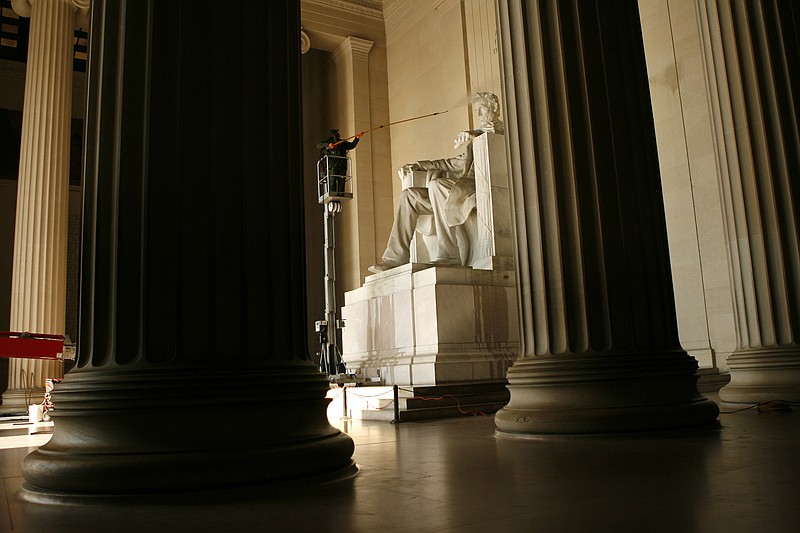Read more
* Patriotism at fever pitch for first Veterans Day since July 16 attacks * Sohn: Veterans Day comes with a budget and uncertainties * Area businesses offer specials, free meals for veterans
The stone statue of the man who sits in the Lincoln Memorial and looks outward at the Washington Monument and the United States Capitol in the far distance now has even more to gaze upon.
The National World War II Memorial has risen between the man who shepherded the country during the Civil War and the obelisk in memory of the man who led the Revolutionary War. To his near left is the Vietnam Veterans Memorial, and to his near right is the Korean War Veterans Memorial. All have been built in the last 33 years
Lincoln, who wept for the 620,000 who perished in the conflict between the Union and the Confederacy, now overlooks memorials to the more than 405,000 Americans who died in World War II, the more than 36,000 who were lost in the Korean War and the more than 58,000 who perished in Vietnam.
On Veterans Day, it's worth noting that the 16th president's visage now looks over monuments to more than 1.1 million war dead.
We can't always be in Washington, D.C., to see how these men and women are honored in marble and granite, but it is always appropriate to honor them in our minds and our hearts. Even when it's not Nov. 11.
For those who have never seen it in person, the Vietnam Veterans Memorial is not the wall you see in photographs, a monolith standing at ground level where you stare at the names of those who perished in the war between 1959 and 1975.
No, if you don't know where to look, you might miss it in Constitution Gardens. The wall itself is below ground level and is reached by a pathway along which the wall rises diagonally - from 8 inches to 10.1 feet - as the path slopes below ground level.
A visitor can be standing on the ground above and just back from the memorial, in fact, and not know the chronological listing of names of those killed in action or missing in action in the war is there.
In a way, for many years, Vietnam veterans were like that wall. Because it was the war that Americans just wanted to forget, its veterans were similarly glossed over, were hard to see. They were like the uncle at the family reunion everybody tried to avoid.
While its service members experienced the incessant rain, muddy rice paddies, whir of helicopter blades, long stretches of boredom and intense firefights of Southeast Asia, those left behind endured the protests, disrupted campuses and guns vs. butter arguments.
Indeed, it was the war nobody wanted to discuss.
The Korean War, on the other hand, is known as "The Forgotten War," words which grace its memorial across from the Vietnam Veterans Memorial in what as known as West Potomac Park.
If you walk up the park path and are not expecting it, the memorial can be slightly disconcerting. Suddenly, 19 larger than life steel statues in full combat gear - with tired and care-worn faces - are marching through juniper bushes toward the path. A black granite wall to their right displays sandblasted images of the land, sea and air troops.
The 1950-1953 war, coming as it did between what people consider a defensible World War II - what author Studs Terkel once referred to in an oral history as "The Good War" - and the quagmire of Vietnam, is forgotten by many.
The conflict, short but bloody, ended in a stalemate at the 38th parallel, the demarcation line that still divides North Korea from South Korea today.
In Lincoln's mid-distance, above the reflecting pool in front of him, is the National World War II Memorial.
The memorial consists of 56 granite pillars arranged in a semicircle around a large fountained plaza with triumphal arches on opposite sides. The pillars contain the names of the 48 states at the end of the war in 1945, along with Washington, D.C., and seven territories (including Alaska and Hawaii). The arches represent the Atlantic and Pacific theaters of the war.
On the west side of the memorial is The Freedom Wall, which is emblazoned with 4,084 gold stars, each representing 100 Americans who died in the war.
Some day, probably also on the National Mall, will be memorials to those who gave their lives in the Iran and Afghanistan wars. Then, as now, if American remains the strong, free country it has been, its citizens still may argue whether the two wars in the first years of the 21st century were worth it. But may they never differ over the ultimate price paid by its veterans.
